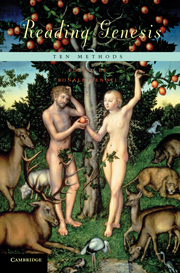Book contents
- Frontmatter
- Contents
- Contributors
- Acknowledgments
- Reading Genesis
- Introduction
- 1 Literature
- 2 Cultural Memory
- 3 Sources and Redaction
- 4 Gender and Sexuality
- 5 Inner-Biblical Interpretation
- 6 Rabbinic Interpretation
- 7 Interpretation in the Early Church
- 8 Translation
- 9 Modern Literature
- 10 Modern Theology
- Index of Biblical Citations
- General Index
- References
5 - Inner-Biblical Interpretation
Published online by Cambridge University Press: 05 June 2012
- Frontmatter
- Contents
- Contributors
- Acknowledgments
- Reading Genesis
- Introduction
- 1 Literature
- 2 Cultural Memory
- 3 Sources and Redaction
- 4 Gender and Sexuality
- 5 Inner-Biblical Interpretation
- 6 Rabbinic Interpretation
- 7 Interpretation in the Early Church
- 8 Translation
- 9 Modern Literature
- 10 Modern Theology
- Index of Biblical Citations
- General Index
- References
Summary
Introduction
Inner-biblical interpretation is the light that one biblical text casts onto another – whether to solve a problem within the interpreted text or to adapt the interpreted text to the beliefs and ideas of the interpreter. The interpreting text may stand far from the interpreted text, or be next to it, or may even be incorporated within it. Not always does a text function solely as the interpreting or as the interpreted one: sometimes the two will mutually interpret one another. In this chapter, we look at the phenomenon of inner-biblical interpretation through the example of one story, Genesis 27, the tale of Jacob deceiving his father, Isaac, in order to receive the blessing that Isaac had intended for Esau, Jacob's brother and Isaac's firstborn – and the many interpretations of that story that we find inside the Hebrew Bible.
Before turning our attention to the story and its interpretations, let us consider more fully the phenomenon of inner-biblical interpretation. There are both overt and covert types of inner-biblical interpretation. Examples of overt interpretation, in which a text openly refers to another well-known text, are found – to name a few examples – in Chronicles’ paraphrase of the historiographic literature; in the way in which the writer of the historical psalm, Psalm 78, treats its Pentateuchal sources; and even in the way the law of the Hebrew slave in the Book of the Covenant (Exodus 21:2–11) is interpreted in Deuteronomy 15:12–18. The covert type of inner-biblical interpretation is more difficult to discern. To detect this type of interpretation, the reader must be alert and sensitive to allusions planted by writers, editors, compilers, and annotators who embedded a literary unit in a certain place or who placed it within or juxtaposed it to another unit in order to cast the latter in new light.
Information
- Type
- Chapter
- Information
- Reading GenesisTen Methods, pp. 92 - 118Publisher: Cambridge University PressPrint publication year: 2010
References
Accessibility standard: Unknown
Why this information is here
This section outlines the accessibility features of this content - including support for screen readers, full keyboard navigation and high-contrast display options. This may not be relevant for you.Accessibility Information
- 4
- Cited by
